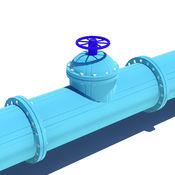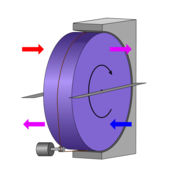-
Category Productivity
-
Size 37.9 MB
IMI Hydronic Engineering proudly presents HyTools, the user-friendly hydronic calculator App for HVAC professionals. Features include:* Hydronic calculator (enter any two values and get the third one):- flow - Kv/Cv - pressure drop- power - flow - temperature difference- flow - valve setting - pressure drop* Dirt and air separator pressure drop calculation* Valve sizing and presetting* Radiator power estimation (panel and column)* Radiator valve sizing and presetting* Pipe sizing* Unit conversion* Run-time selection of localisation* Run-time selection of languageStay tuned for great upcoming updates adding further hydronic calculation functions. IMI Hydronic Engineering is part of the international engineering group IMI plc which is listed as a member of the FTSE 100 on the London Stock Exchange.
HyTools alternatives
iManifold
The iManifold App Calculates HVAC/R system performance and troubleshoots system problems through user inputs and dynamic, live system data. With over 40 selectable refrigerants and equipment profiling options, the iManifold app can be custom tailored for many common HVAC/R systems in the field.
-
size 29.2 MB
Psyclone HVAC Lite
Psyclone Lite by Silverglance Software provides a toolkit of HVAC psychrometric calculations for low-volume flowrate systems (up to 2000 cfm / 1 m3/s), allowing individual processes to be examined and supply air volume, condition or capacity to calculated. Psyclone Lite can be upgraded to remove flowrate restrictionsPsyclone operates in either metric or imperial units.
-
size 1.4 MB
testo Refrigeration
Download the testo APP Refrigeration to your Smartphone / Tablet for free and make your everday work at AC/R Systems more comfortable. Features: Remote view of your measured values on a Smartphone / Tablet Track changes using the graphical trending function Update the refrigerants in the instrument via the APP easily Create .pdf or .csv (Excel) reports Include a photo of the measuring location in the report Send out reports via e-mail directly Range of appr. For working with the Smart Probes, please use the testo Smart Probes APP.
-
size 60.0 MB
testo Smart Probes
The testo Smart Probes APP makes your mobile device to a remote control and measurement data centre. Application specific menus (e.g.):- AC + Refrigeration: automatic calculation of system parameters, like superheat or subcooling- Volume Flow (outlet / duct): easy set up of your measurement and performing a punctual or continuous measurement.- IR Temperature and Mould Indication: contactless temperature measurement with fast photo documentation and detection of areas with mould risk. 15m (depends on mobile device used)Preconditions for using:- Use a testo Smart Probe (testo 405i, 410i, 605i, 510i, 115i, 549i, 805i, 905i), a testo 552 or a testo 770-3- Requires iOS 8.3 or newer, plus mobiles end device with Bluetooth 4.0
-
size 62.9 MB
Munters PsychroApp
Munters PsychroApp is the quick and easy psychrometric calculation tool designed for the iPhone and iPod touch which can run unmodified on an iPad too making accurate calculations of the thermodynamic properties of moist air easy. Calculate the total, sensible, latent and moisture loads of any process more accurately than using psychrometric charts. Air and Water Vapour Properties in PsychroAppPsychrometricFdb / Cdb - Dry Bulb TemperatureFwb / Cwb - Wet Bulb Temperature%RH - Relative HumidityBtu/lb / kJ/kg - EnthalpyFdp / Cdp - Dew Point Temperaturegr/lb / g/kg - Humidity Ratioft/lb - m/kg - Specific Volumein Hg VP / mm Hg VP - Vapour Pressurelb/ft / kg/m - DensityPPMw - Parts Per Million by weightPPMv - Parts Per Million by volumegr/ft / g/m - Absolute HumidityPressureAlt in Ft / m - Altitude (elevation)psia / kPa - Absolute PressurePsychroApp is registered software from Munters - the leading energy efficient air treatment company
-
size 3.1 MB
More Information About alternatives
Heating&Cooling: Pipe Sizing, Pressure Drop, Floor Heating, Heating Cost Calculators
Bring more energy efficiency to heating systems. Pipe sizing and pressure drop calculation for heating systems, calculation of floor heating system characteristics, hydraulic separator sizing and cost savings calculation for different heating sources. Calculation is based on current system consumption.
-
size 1.0 MB
Pipeline Basics - Mechanical & Petroleum Engineers
Pipeline Basics contains a large selection of Pipeline equations, tables and reference material. Includes Pipeline Sizing equations and tables as well as tables and reference material for valves, corrosion and flanges. Table of Contents: - Ball Valves- Boiling Fluids- Bolt Stretching- Bronze Flanges (ASME/ANSI) - Butterfly Valves- Carbon Flanges (ASME/ANSI) - Carbon Steel Flanges- Carbon Steel Pipes- Cast Iron Flanges- Comparing American and British Piping Standards- Copper Pipes (Insulation and Heat Loss)- Cross Reference of ASTM Material Specifications- Diaphragm Materials in Diaphragm Valves- Electrode Potential and Galvanic Corrosion- Epoxy - Equation of Continuity- Equation of Mechanical Engineering- Flow Coefficient Cv and Flow Factor Kv- Gasket Characteristics- Identification Tests for Stainless Steel- Light Oils (Recommended Suction Flow Velocity) - Natural Gas (Pipe Sizing) - Non Destructive Testing- Nominal Pipe Size and Diameter Nominal - Pipe Formulas- Pipe Velocities- Pipes (Relative Capacities) - Pipes and Tubes (Temperature Expansion) - Pipes Fractional Equivalents- Piping and Equipment Identification Labels- Piping Materials and Galvanic Corrosion- Plastic Pipes and Operating Pressure- Pneumatic Powder and Solids - Pneumatics (Solid Transports, Particles Sizes, Separator Types)- Polyester (Chemical Resistance) - Pressure to Head Unit Converter Table- Propane Gas (Pipe Sizing) - Pumping Boiling Liquids (Delivery Flow Velocities)- Pumping Light Oils (Delivery Flow Velocities) - Recommended Delivery Flow Velocity of Viscous Liquids- Reynolds Numbers- Slurry Transport and Minimum Flow Velocity - Stainless Steel Pipes (Pressure Ratings, Dimensions, Weights ASME/ANSI) - Steel Pipes Dimensions- Steel Tubes BS 1387 (EN 10255) - Suction Flow Velocities of Water- Threaded and Socket Welded Fittings- Types of Corrosion- Valve Selection Guide- Valve Types for Specific Services- Valves (Typical Operating Ranges and Temperatures) - Viscous Fluids (Recommended Suction Flow Velocities) - Water Delivery Flow Velocities* All Content is Searchable* All Content is available offline (no need for WiFi or Internet Connection) * Please send us any questions, comments or suggestions using our website
-
size 28.8 MB
-
version 3.9
Heating and Natural Gas: Pipe Sizing, Pressure Drop and Cost Calculations
If you are a heating, cooling or natural gas services professional, these apps should make your life a bit easier. This app bundle enables you to:- Perform pipe sizing and pressure drop calculations for heating, cooling and natural gas installations;- Calculate characteristics of underfloor heating systems;- Perform sizing of a hydraulic separator for hydronic heating or cooling:- Calculate cost of heating for different heating sources, including heat pumps, gas, oil, firewood, pellet and wood chip boilers. Calculation is based on current system consumption.
-
size 1.4 MB
TLV ToolBox
Turn your mobile device into a light & portable steam calculation tool with TLV Toolbox. Reduce trips back and forth while working onsite with this valuable tool. Helpful for design oreveryday maintenance of control valve stations, condensate recovery systems, and muchmore FEATURES:- Steam Tables (saturated and superheated)- Steam Pipe Sizing- Condensate Pipe Sizing- Heating Calculations- Cv and Kv Values- Stall Point- and moreTo access the web-version, visit:http://www.tlv.com/global/TI/calculator/For more information on steam and condensate systems, visit http://www.tlv.com
-
size 3.6 MB
-
version 5
Hydraulic Heat Calculator
The Hydraulic Heat Calculator is a valuable tool that can help in designing, troubleshooting and correcting heat issues within a system. There are many calculation screens that can be used to determine heat generation from pumps/motors, Tank heat dissipation, Radiator sizing /performance, and others. Specific Calculations include:Enter Oil Volume and Power input to determine rate of temperature changeEnter system flow, inlet and outlet radiator temperatures to determine radiator performanceEnter pressure and oil flow to determine temperature increase and heat generatedEnter motor/pump specs to determine temperature increase and heat generatedEstimate power required to heat oil tanks in cold environmentsEstimate tank heat dissipationEmpirical cooling calculation to determine radiator size requirementAll calculations can be done in metric or imperial units.
-
size 4.1 MB
-
version 1.2
Hydraulics and Waterworks Calc.
Hydraulics Calculator contains 94 Calculators and Converters, that can quickly and easily calculate and convert different Hydraulics, Water works and Civil Engineering parameters. Available in Metric and Imperial Units Available in English, Franais, Espaol, Italiano, Deutsch & Portugus Capillary Rise Viscosity Kinematic Viscosity Hydrostatic Pressure Pressure Head Velocity Head True Velocity Head Specific Energy Head Head Loss (Bernoulli Equation) Total Energy - Elemental Volume of Fluid Total Head of Flowing Fluid Average Velocity of Flow Summation of all Forces (X direction) Froude Number Reynolds Number Weber Number Head Loss due to Friction Head Loss due to Friction (Darcy-Weisbach Formula) Chezy Velocity Chezy Coefficient Manning Flow Velocity Manning Flow Velocity using Pipe Diameter Flow Rate (Manning Formula) Head Loss due to Friction (Manning Formula) Pipe Diameter (Manning Formula) Mean Flow Velocity (Hazen-Williams) Mean Flow Velocity - Pipes Flowing Full (Hazen-Williams) Fluid Flow Rate (Hazen-Williams) Head Loss due to Friction (Hazen-Williams) Pipe Diameter (Hazen-Williams) Head Loss across a sudden enlargement of Pipe Diameter (Bernoulli Equation & Archer Equation) Head Loss due to Gradual Conical Enlargement Head Loss across a sudden contraction of Pipe Head Loss across a sudden contraction of Pipe (Brightmore Equation) Head Loss - Pipe Fittings Loss Coefficient Orifice Flow Rate Coefficient of Contraction Initial Velocity of Fluid Jets Gage Pressure at Tube Entrance (Conical Tubes) Velocity of Wave in a Pipe (Water Hammer) Internal Pressure in Pipe Stress on Pipe Material Section Factor Critical Depth of Flow - Open Channel Flow Force - Hydraulic Jump Rate of Change of Momentum - Hydraulic Jump Head Loss - Hydraulic Jump Stress on Pipe due to Temperature Change Movement in Length of Pipe due to Temperature Change Resultant Force on Bend in Pipe Elevation Difference between Headwater and Tailwater (Entrance and Exit Submerged) Velocity of Flow in Culvert (Entrance and Exit Submerged) Elevation Difference between Headwater and Tailwater (Entrance Submerged/Unsubmerged & Free Exit) Velocity of Flow in Culvert (Entrance Submerged/Unsubmerged & Free Exit) Flow Rate - Open Channel Flow Average Velocity - Rectangular Channels Critical Depth - Rectangular Channels Flow Rate - Rectangular Channels Discharge of Fluid per Unit Length - Rectangular Channels Minimum Specific Energy - Rectangular Channels Average Velocity - Triangular Channels Critical Depth - Triangular Channels Flow Rate - Triangular Channels Average Velocity - Parabolic Channels Critical Depth - Parabolic Channels Flow Rate - Parabolic Channels Average Velocity - Trapezoidal Channels Critical Depth - Trapezoidal Channels Flow Rate - Trapezoidal Channels Minimum Specific Energy - Trapezoidal Channels Area of Cross Section - Circular Channels Critical Depth - Circular Channels Top Width - Circular Channels Flow Rate - Circular Channels Flow Rate - Rectangular Weir Flow Rate - Triangular Weir (Notch Angle of 90 degrees) Flow Rate - Triangular Weir (Notch Angle of 60 degrees) Flow Rate - Triangular Weir (Notch Angle of 30 degrees) Flow Rate - Trapezoidal Weir Flow Rate - Broad Crested Weir Quantity of Sediment transported as Bed Load (Schoklitsch Formula) Evaporation Rate (Meyer Equation) Wind Factor Peak Discharge (Rational Formula) Rainfall Intensity (Steel Formula) Flow Rate - Groundwater (Darcys Law) Fire Demand Rate Flow Rate - Gravity Well (Dupuit Formula) Flow Rate - Artesian Well Economic Pipe Diameter Flow Rate - Venturi Flow Meter Power obtained from Water Flow
-
size 16.2 MB
-
version 4.0
DWSIM Calculator
DWSIM Calculator is an app to calculate Phase Equilibria, properties of mixtures of substances (compounds) and Unit Operation models using advanced thermodynamics. Based on the model library of DWSIM, an award-winning open-source process simulator for desktops, DWSIM Calculator for iOS features:- An intuitive interface for desktop process simulator users;- Experimental data for more than 400 compounds;- 6 calculation modes: Single Compound Properties, VLE/VLLE Phase Equilibria, True Critical Point, Phase Envelope, T-x-y and P-x-y Binary Envelopes;- 7 thermodynamic model sets: Peng-Robinson and Soave-Redlich-Kwong Equations of State, NRTL, UNIQUAC, Modified UNIFAC (Dortmund), Raoults Law and IAPWS-IF97 Steam Tables;- 3 state specifications: Temperature/Pressure, Temperature/Vapor Fraction and Pressure/Vapor Fraction;- Phase properties: Enthalpy, Entropy, Compressibility Factor, Density, Molecular Weight, Heat Capacity, Thermal Conductivity and Viscosity;- Single-compound properties: Critical Parameters, Acentric Factor, Chemical formula, Structure formula, CAS Registry Number, Boiling Point Temperature, Vapor Pressure, Heat of Vaporization, Ideal gas Enthalpy, Ideal gas Enthalpy of Formation at 25 C, Ideal Gas Gibbs Free Energy of Formation at 25 C, Ideal Gas Entropy, Heat Capacity Cp, Ideal Gas Heat Capacity, Liquid Heat Capacity, Solid Heat Capacity, Heat Capacity Cv, Liquid Viscosity, Vapor Viscosity, Liquid Thermal Conductivity, Vapor Thermal Conductivity, Solid Density, Liquid Density and Molecular Weight;- Unit Operation calculation models: Valve, Heater/Cooler, Pump, Compressor/Expander, Heat Exchanger, Gas-Liquid Separator. More information available at http://dwsim.inforside.com.br/wiki/index.php?title=Calculator
-
size 63.0 MB
-
version 1.3.1
DWSIM Simulator
DWSIM Simulator is a Steady-State Chemical Process Simulator, featuring:- Offline functionality: no need to connect to online databases or servers, DWSIM runs completely offline on your device, wherever you are - Touch-enabled Process Flowsheet Diagram (PFD) Drawing Interface: A hardware-accelerated PFD interface with touch support allows Chemical Engineers to build complex process models in a few minutes- VLE/VLLE/SVLE calculations using Equation of State and Activity Coefficient models: calculate fluid properties and phase distribution with advanced thermodynamic models- Compound database with extensive data for more than 1500 compounds- Rigorous Thermodynamic Models*: Peng-Robinson EOS, Soave-Redlich-Kwong EOS, Lee-Kesler-Plcker, Chao-Seader, Modified UNIFAC (Dortmund), UNIQUAC, NRTL, Raoults Law and IAPWS-IF97 Steam Tables- Thermophysical state (phase) properties: Enthalpy, Entropy, Internal Energy, Gibbs and Helmholtz Free Energies, Compressibility Factor, Isothermal Compressibility, Bulk Modulus, Speed of Sound, Joule-Thomson Expansion Coefficient, Density, Molecular Weight, Heat Capacity, Thermal Conductivity and Viscosity- Single-compound properties: Critical Parameters, Acentric Factor, Chemical formula, Structure formula, CAS Registry Number, Boiling Point Temperature, Vapor Pressure, Heat of Vaporization, Ideal gas Enthalpy, Ideal gas Enthalpy of Formation at 25 C, Ideal Gas Gibbs Free Energy of Formation at 25 C, Ideal Gas Entropy, Heat Capacity Cp, Ideal Gas Heat Capacity, Liquid Heat Capacity, Solid Heat Capacity, Heat Capacity Cv, Liquid Viscosity, Vapor Viscosity, Liquid Thermal Conductivity, Vapor Thermal Conductivity, Solid Density, Liquid Density and Molecular Weight- Comprehensive Unit Operation Model set*, including Mixer, Splitter, Separator, Pump, Compressor, Expander, Heater, Cooler, Valve, Shortcut Column, Heat Exchanger, Component Separator, Pipe Segment, Rigorous Distillation and Absorption Columns- Support for Chemical Reactions and Reactors*: DWSIM features support for Conversion, Equilibrium and Kinetic reactions, together with their respective Reactor models- Flowsheet Parametric Studies: Use the Sensitivity Analysis Tool to run automated parametric studies on your process model; The Flowsheet Optimizer tool can bring the simulation to an optimum state according to user-defined criteria; The Calculator tool can read flowsheet variables, perform math operations on them and write the results back to the flowsheet- Petroleum Characterization: Bulk C7+ and TBP Distillation Curve characterization tools enables creation of pseudocompounds to simulate petroleum processing facilities- Parallel multicore CPU calculation engine: a fast and reliable flowsheet solver takes advantage of the multicore CPUs on modern mobile devices- Save/Load XML simulation files on the device or in the cloud- Export simulation results to PDF and Text documents* Some items are available through one-time in-app purchasesABOUT CHEMICAL PROCESS SIMULATIONChemical Process Simulation is a model-based representation of chemical, physical, biological, and other technical processes and unit operations in software. Basic prerequisites are a thorough knowledge of chemical and physical properties of pure components and mixtures, of reactions, and of mathematical models which, in combination, allow the calculation of a process in a computing device. The goal of a process simulation is to find optimal conditions for a process.
-
size 123 MB
-
version 2.3.2
HVAC-calculator
HVAC Calculator is an app that performs many calculations that are useful to have available for anyone working with or have interest in HVAC and energy use in buildings. The app performs many of the calculations that you never remember the formulas for when you need them for quick calculations, for example in a meeting or out on the construction site. The app helps you calculate all this and more:-SFP from measured/design fan power and airflow-SFP at reduced airflow for VAV ventilation-SFP at design conditions or maximum performance for VAV ventilation-Temperature efficiency of heat recovery-Temperature after heat recovery unit (HRU) in air handling unit (AHU)-Temperature of exhaust air from air handling unit after heat recovery-Actual temperature efficiency of heat recovery when the exhaust temperature is limited to minimum 5C for reuse as frost free garage ventilation-Air velocity in ducts with known dimensions and airflow-Maximum airflow in a duct with dimensions and maximum air velocity as specified requirements-Dimensions of rectangular and circular spiral ducts for specified air flow and velocity requirements-Pressure drop in Pa/m for rectangular and circular spiral ducts-Equivalent diameters for rectangular ducts-Hydraulic diameter for rectangular ducts
-
size 24.1 MB
-
version 2.2













